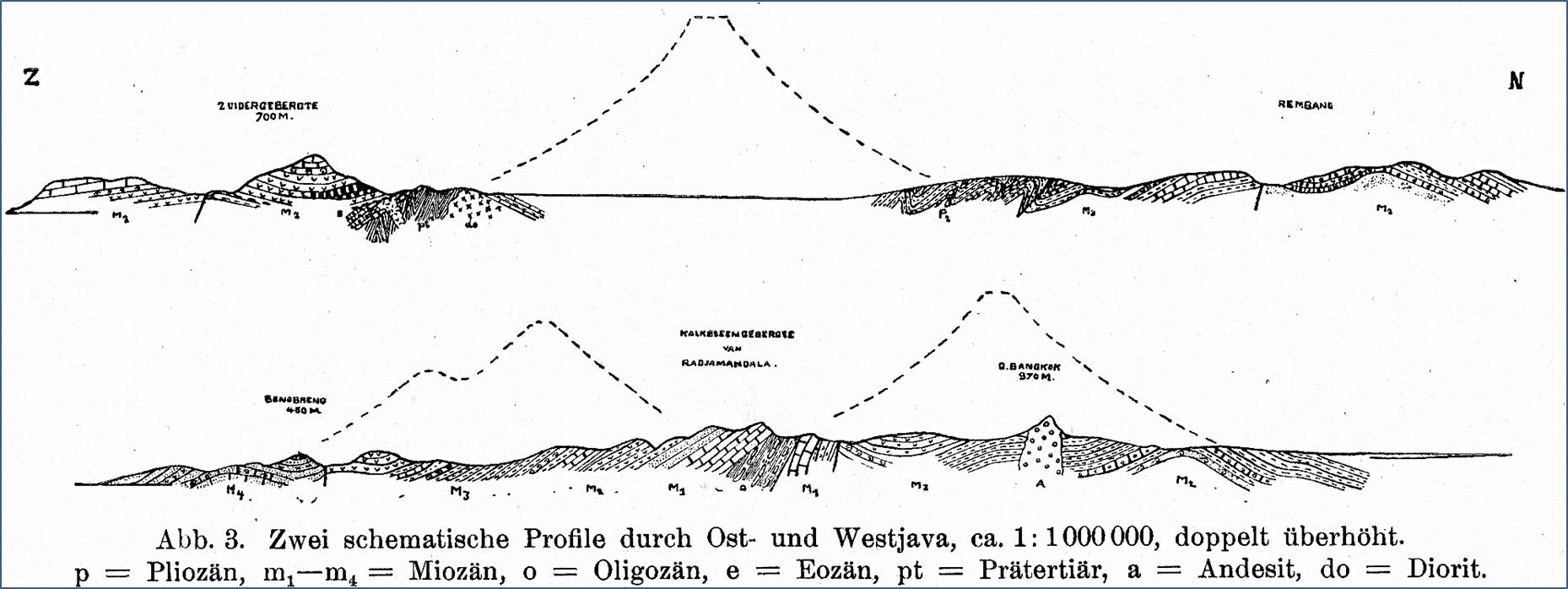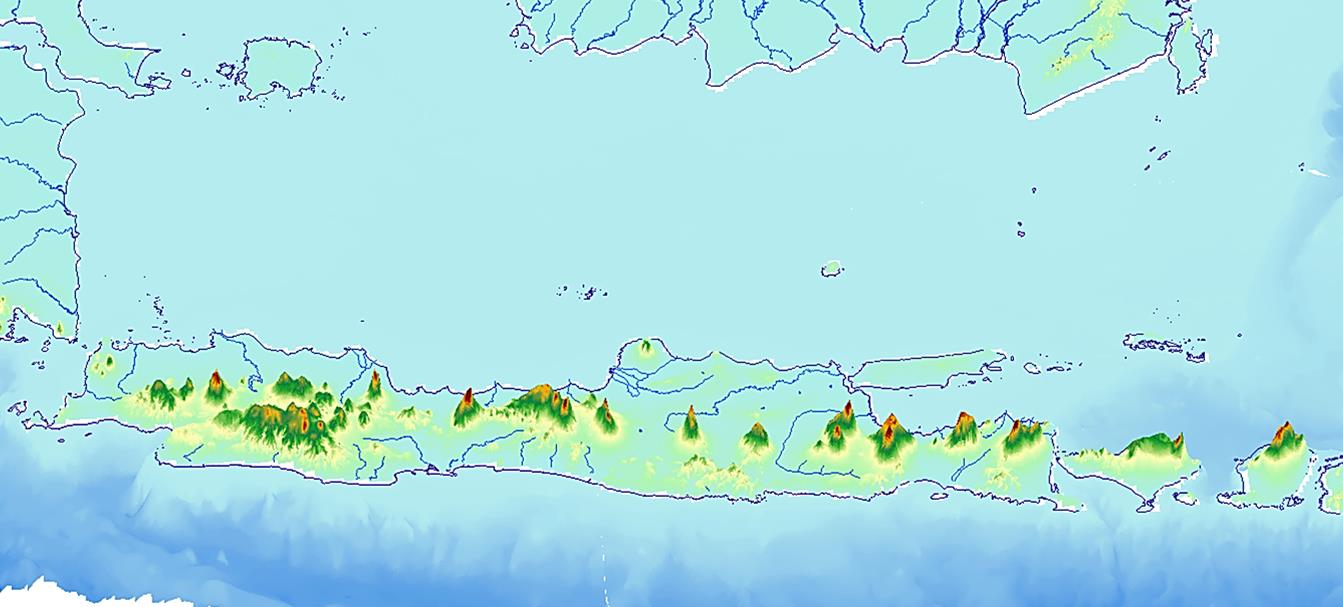III.1. Java - General, Onshore geology, Forearc
This sub-chapter deals with papers on the geology of Java, including some from the offshore forearc region, but not papers on Quaternary volcanics. With > 1845 papers it is by far the largest sub-chapter.
The island of Java has a long history of geological studies, dating back to the mid-1800's. Junghuhn (1854) in his famous book on the natural history of Java dispelled the then current notion that all of Java was composed of volcanic rocks. The first monograph dedicated to the geology of Java was by Verbeek and Fennema (1896; with the first geologic map).
Focus areas of Java geology research, all with numerous papers, have been on structure, volcanism, hydrocarbons, Eocene- Recent stratigraphy and
paleontology, mineral deposits and Pleistocene hominids and mammal fossils.

S-N cross-section across central Java (Verbeek & Fennema 1896).

S-N cross-sections across East Java (top) and West Java (Gerth 1931).
The western part of the Java Sea is a continuation of the Paleozoic- Early Mesozoic continental basement complexes of Sumatra and Borneo. Most of Java island appears to be underlain by Late Cretaceous- Eocene age accretionary complexes and Paleogene arc volcanics. Outcrops of the oldest 'basement' are found in only three relatively small areas in Central (Luk Ulo, Bayah) and SW Java (Ciletuh).
It has been suggested from the composition of Quaternary volcanic rocks that parts of East Java may be underlain by oceanic crust. Other evidence, like the presence of Archean-age zircons in E Miocene volcanics of SE Java suggest the subsurface presence of Australian continental material there.
The backbone of Java is a series of relatively young active volcanoes, most of them about 3000m high, and spaced about 80km apart. A long belt of outcrops of latest Oligocene- earliest Miocene 'Old Andesite' volcanic arc deposits follows today's South Coast (Southern Mountains). These probably formed the only land areas through most of Late Eocene- Pliocene time, when most of the northern half of Java was a marine basin. The present-day land area formed mainly since the Pleistocene by a combination of renewed arc volcanism, an episode of N-vergent compressional tectonics N of the modern arc and rapid shoreline progradation driven by erosional products of this activity.
Oil and gas seeps had been known for a long time in East and Central Java. Descriptions of these started to appear in the literature by the 1850's (Junghuhn 1854, Von Baumhauer 1869). The first shallow oil exploration well was drilled in 1871, at an oil seep near Cirebon in C Java. The first discovery was the Kuti Field in in 1888, near Surabaya, NE Java. This was followed by many other discoveries in the Cepu area at Kawengan (1892) and Ledok (1893). Exploration activity and oil production already started to decline in the 1920's.
The traditional plays in NE Java were in M Miocene- Pliocene sands and Globigerina calcarenites in young surface anticlines. Only since the late 1980's has the oil industry become aware of the successful deeper play in Oligocene- E Miocene reefal builups, extending from the Cepu area into Madura Straits.
NW Java has been area of oil and gas discoveries since the late 1960's, mainly in the offshore. Like on Sumatra, all oil and gas fields appear to be above, or within migration distance of, two Oligocene rift basins with lacustrine and coaly source rocks, the Arjuna and Sunda basins. Main reservoirs are Late Oligocene- E Miocene Talang Akar/ Cibulakan fluvial- deltaic sandstones and Early Miocene Baturaja limestones. The southern part of the Arjuna basin continues into the onshore, but rapidly deepens towards a young thrust belt and contains mainly small gas discoveries.
The Java Sea off East Java- Madura has some some small oil and gas discoveries, but, despite the widespread distribution of Oligo-Miocene carbonate and clastic reservoir rocks, exploration in this area has been rather disappointing.
The Java forearc zone has not been successful for hydrocarbons. Surface seeps are not known (except in the Banyumas area of Central Java) and the limited number of wells drilled there were dry. Traditional wisdom blames this on the absence of Eo-Oligocene rift systems and unusually low geothermal gradients.
The volcanic belt of West Java has yielded a number of moderate-size gold-silver deposits.
Java lacks the commercial Tertiary coal deposits known from S Sumatra and SE Kalimantan. Only a few small-scale coal exploitations are known from the Eocene of Bayat, SW Java and the Middle Miocene Ngrayong Fm at the W end of the Rembang zone, NE Java (figure below).

WSW-NE cross-section across Middle Miocene coal-bearing sediments of W Rembang zone NE Java ('T Hoen 1918).
Java has also been a focus area of numerous studies on volcanoes and on Pleistocene mammals and hominids. See more on this under the chapters on these topics.
Suggested Reading Java: (not a complete listing of all relevant papers)
| General, Historic |
Junghuhn 1854, Martin 1891, Verbeek and Fennema 1896, Van Bemmelen 1949, Lunt 2013) |
| Tectonics |
Van Bemmelen 1949, Sujanto and Sumantri 1977, Chotin et al. 1980, 1984, Dardji Noeradi et al. 1994, Soenandar 1997, Armandita et al. 2002, Sribudiyani et al. 2003, Satyana et al. 2004, Satyana 2005, 2006, 2007, Clements and Hall 2007, 2008, Hall et al. 2007, Clements et al. 2009, Seubert and Sulistianingsih 2008, Granath et al. 2010, 2011, Lunt 2013 |
| Cenozoic Stratigraphy |
Paltrinieri et al. 1976, Suyanto and Sumantri 1977, Baumann 1982 |
| Pre-Tertiary |
Bothe 1929, Harloff 1929, Tjia 1966, Ketner et al. 1976,Suparka and Soeria-Atmadja 1991, Wakita et al. 1991, 1994Harsolumakso and Noeradi 1996, Miyazaki et al. 1998, Parkinson et al. 1998, Prasetyadi et al. 2002-2006, Kadarusman et al. 2007, 2010 |
| Java Volcanism |
Bellon et al. 1989, Leterrier et al. 1990, Soeria-Atmadja et al. 1988, 2004,Soeria-Atmadja and Noeradi 2005, Bronto et al. 2005, 2009, 2010, Smyth et al. 2006, 2007, 2008, 2018) |
| Hydrocarbons NW Java |
Arpandi and Sujitno 1975, Burbury 1977,Soulisa and Sujanto 1979, Molina 1985, Wight et al. 1986, 1997, Ponto et al. 1989, Yaman et al. 1991, Aldrich et al. 1995, Gresko et al. 1995, Wight 1995, Noble et al. 1997, Nugrahanto. and Noble 1997 |
| Hydrocarbons NE Java |
Weeda 1958, Soetantri et al. 1973, Soeparyono and. Lennox 1989,Ardhana et al. 1993, Schiller et al. 1994, Willumsen and Schiller 1994, Cole and Crittenden 1997, Kusumastuti et al. 2000, 2002, Satyana and Darwis 2001, Purwaningsih et al. 2002, Satyana 2002, Satyana and Purwaningsih 2002, 2003, Triyana et al. 2007, White et al. 2007, Van Simaeys et al. 2011, Ahdyar et al. 2017 |
| Hydrocarbons Java Sea |
Kenyon 1977, Phillips et al.(1991, Matthews and Bransden 1995,Reynolds 1995, Kaldi et al. 1999, Mudjiono and Pireno 2002,Johansen 2003, 2005, Carter et al. 2005, Takano et al. 2008 |
| South Java forearc |
Bolliger and De Ruiter 1975, Lehner et al. 1983, Masson et al. 1990, Kopp et al. 2002, Schluter et al. 2002, Yulianto et al. 2007, Shulgin et al. 2011, Deighton et al. 2011 |
| W Java Gold |
Marcoux et al. (1993, 1996), Marcoux and Milesi (1994), Milesi et al. (1994, 1999) |
III.3. Java - Quaternary Volcanism
This sub-chapter III.3 in Bibliography 7.0 contains >300 references on Quaternary volcanism on Java, focusing on geology and compositions of volcanic
products, and not including papers on eruption histories or volcanic hazards. There does not appear to be a modern synthesis paper or book on the
history and characteristics of volcanism on Java.

Volcanoes of Java are part of the active Sunda Arc, where large active volcanic centers tend to be spaced at ~70-80 km apart.
At least two parallel Cenozoic volcanic arc systems can be distinguished on Java, separated in space by >50km and in time by ~20 million years:
- Modern volcanic arc, forming the present-day backbone of Java. It is a series of young active typical calk-alkaline volcanoes, part of the Sunda Arc;
- Oligocene- earliest Miocene 'Old Andesites' volcanic arc of the Southern Mountains. Remnants of this eroded Late Oligocene- Early Miocene volcanic arc system are well exposed in outcrops in today's Southern Mountains of Java. They are locally thick andesitic and dacitic series, in which several eruptive centers have been identified (Bronto 2003, 2009). Radiometric ages and associated marine sediments suggest mainly latest Oligocene- earliest Miocene ages (20-25 Ma)
The >50km northward shift of the axis of arc magmatism on Java between Early Miocene and Late Pliocene- Recent Sunda Arc was probably not a continuous, gradual process. The two likely represent two separate volcanic episodes/ belts, with a temporal gap in volcanism between 11-18 Ma or longer (Bellon et al. 1989).
III. 4. Madura- Madura Straits
This sub-chapter III.4 of Bibliography 7.0 contains 41 references on Madura island and Madura Straits.
Madura island is a major anticlinorium, with outcrops of folded Neogene marine clastic and carbonate sediments. It is a continuation of the Rembang zone of the NE Java basin. The offshore Madura Straits basin is an eastern continuation of the Kendeng/ Randublatung zones of the NE Java basin, with a sedimentary section of marine Oligocene- Recent sediments.
Madura Straits is home to a unique hydrocarbon play, with several biogenic gas fields discovered since the late 1990's in reservoirs of Pliocene deep marine planktonic foraminifera grainstones of the Mundu and Paciran Formations. Porosities in these reservoirs is spectacular (up to 45-60%). Gas fields include Maleo, Oyong and MDA. Traps are Pleistocene anticlinal structures, likely inversions of older rifts, and the foram calcarenite reservoirs are sealed by Lidah Formation shales.



